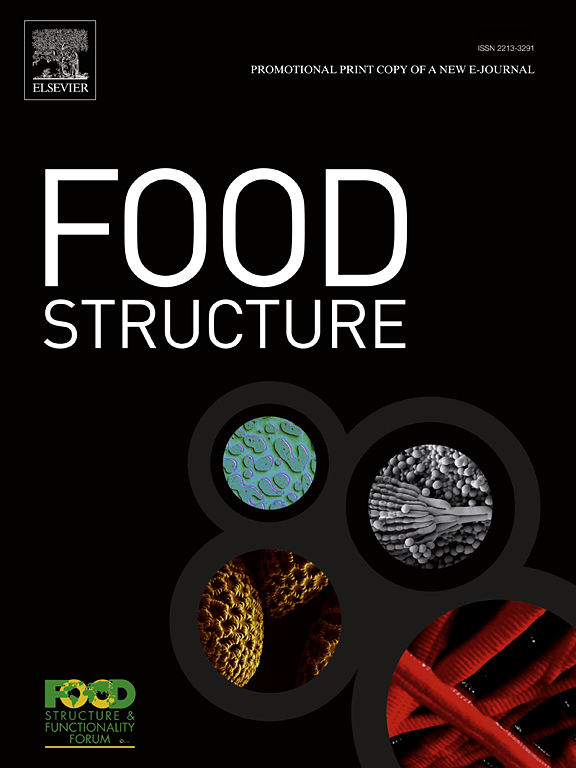菠萝蛋白酶水解的白氏原蝇幼虫蛋白在海绵蛋糕系统中的应用:一种结构和功能上可持续的鸡蛋替代方法
IF 5.9
3区 农林科学
Q1 FOOD SCIENCE & TECHNOLOGY
引用次数: 0
摘要
本研究旨在利用酶解食用昆虫蛋白作为海绵蛋糕的功能性代蛋材料。用菠萝蛋白酶(0-4 %)水解短白弧菌幼虫蛋白,生成具有定制结构特征的样品(PBSC0-PBSC4)。结构和物理化学分析,包括SDS-PAGE,游离巯基含量和表面疏水性,表明酶处理诱导蛋白质展开和暴露活性基团。这些变化增强了泡沫和乳化性能,以及粘度,有助于改善功能性能。水解度从2.76 % (PBSC0)增加到19.28 % (PBSC3),然后在PBSC4时略有下降(15.50 %),表明在高酶水平下效果超优。当应用于海绵蛋糕面糊时,水解产物影响泡沫的微观结构、流动行为和粘聚性。值得注意的是,在混合和成型过程中,PBSC3表现出了优异的储气能力和面糊基质的完整性。所得蛋糕具有中等的物理和质地性能,PBSC3蛋糕的体积为46.50 %,而鸡蛋对照组为79.00 %,硬度值为472.52 gf/cm²,而对照组为210.76 gf/cm²。感官评价证实,PBSC3达到了4.83/7的总体可接受分数,而鸡蛋对照组的可接受分数为5.92/7。虽然一些物理属性不如对照组,但总体质量仍在无蛋产品的可接受范围内。通过将结构修饰(如增加巯基含量和表面疏水性)与功能和产品水平的结果联系起来,本研究为昆虫蛋白的应用提供了一个结构-功能框架,并强调了它们在可持续烘焙系统中的潜力。本文章由计算机程序翻译,如有差异,请以英文原文为准。
Application of bromelain-hydrolyzed Protaetia brevitarsis larvae proteins in sponge cake systems: A sustainable approach to structural and functional egg substitution
This study aimed to utilize enzymatically hydrolyzed edible insect protein as a functional egg replacer in sponge cake. Protaetia brevitarsis larvae proteins were hydrolyzed using bromelain (0–4 %) to generate samples (PBSC0–PBSC4) with tailored structural characteristics. Structural and physicochemical analyses, including SDS-PAGE, free sulfhydryl content, and surface hydrophobicity, revealed that enzymatic treatment induced protein unfolding and exposure of reactive groups. These changes enhanced foaming and emulsifying properties, as well as viscosity, contributing to improved functional performance. Degree of hydrolysis increased from 2.76 % (PBSC0) to 19.28 % (PBSC3), before declining slightly at PBSC4 (15.50 %), indicating a supra-optimal effect at high enzyme levels. When applied to sponge cake batter, the hydrolysates affected foam microstructure, flow behavior, and cohesiveness. Notably, PBSC3 demonstrated superior gas-holding capacity and batter matrix integrity during mixing and molding. The resulting cakes showed moderate physical and textural performance, with PBSC3 cakes achieving 46.50 % volume compared with 79.00 % for the egg control, and hardness values of 472.52 gf/cm² versus 210.76 gf/cm² for the control. Sensory evaluation confirmed that PBSC3 reached an overall acceptability score of 4.83/7, compared with 5.92/7 for the egg control. Although some physical attributes were inferior to the control, overall quality remained within an acceptable range for egg-free products. By linking structural modifications—such as increased sulfhydryl content and surface hydrophobicity—to functional and product-level outcomes, this study provides a structure–function framework for insect protein applications and highlights their potential in sustainable bakery systems.
求助全文
通过发布文献求助,成功后即可免费获取论文全文。
去求助
来源期刊

Food Structure-Netherlands
Chemical Engineering-Bioengineering
CiteScore
7.20
自引率
0.00%
发文量
48
期刊介绍:
Food Structure is the premier international forum devoted to the publication of high-quality original research on food structure. The focus of this journal is on food structure in the context of its relationship with molecular composition, processing and macroscopic properties (e.g., shelf stability, sensory properties, etc.). Manuscripts that only report qualitative findings and micrographs and that lack sound hypothesis-driven, quantitative structure-function research are not accepted. Significance of the research findings for the food science community and/or industry must also be highlighted.
 求助内容:
求助内容: 应助结果提醒方式:
应助结果提醒方式:


